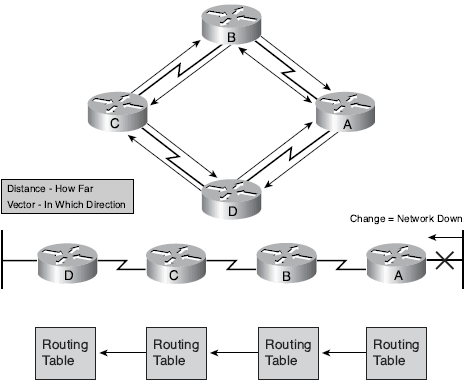Distance Vector Routing Protocols
Distance vector means that information sent from router to router is based on an entry in a routing table that consists of the distance and vector to destination-distance being what it "costs" to get there and vector being the "direction" to get to the destination.
Distance vector protocols are often referred to as Bellman-Ford protocols because they are based on a computation algorithm described by R. E. Bellman; the first description of the distributed algorithm is attributed to Ford and Fulkerson. Distance vector algorithms (also known as Bellman-Ford algorithms) call for each router to send its entire routing table, but only to its neighbors. The neighbor then forwards its entire routing table to its neighbors, and so on. Figure below illustrates this routing table forwarding process.

As Figure above illustrates, whenever a change to the network occurs, this causes the entire routing table to be sent from neighbor to neighbor in order for the network to reconverge in response to the network event (network down). What is not shown is the periodic sending of the routing table between neighbors-a mechanism that double-checks that the routing information each router has is valid.
In this tutorial:
- OSPF Basics
- What Is a Routing Protocol?
- Basic Routing Protocol Operation
- Link-State Versus Distance Vector Routing Protocols
- Link-State Routing Protocols
- OSPF Characteristics
- Integrated Intermediate System-to-Intermediate System
- Distance Vector Routing Protocols
- Selecting a Routing Protocol
- Operational Considerations
- Protocols Supported
- Routing Hierarchies
- IP Address Management
- IP Encapsulation Support
- Technical Considerations
- Routing Updates
- Scalability
- Business Considerations
- SPF Overview
- OSPF Routing Hierarchy
- Hierarchical Network Design Techniques
- Routing Types Within an OSPF Network
- External Routes
- OSPF Areas
- Characteristics of a Standard OSPF Area
- Stub Areas
- Not-So-Stubby Areas
- OSPF Operational Environment
- Types of OSPF Routers
- OSPF Network Types
- Router Identification
- Neighbors
- Adjacencies
